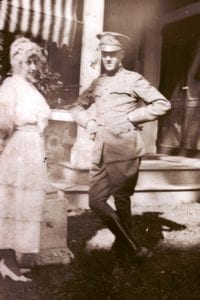Old Field resident’s WWI accounts live through letters, photos

By Beverly C. Tyler
On Nov. 15, 1918, Lt. Marco Carmelich Smith Jr. wrote to his grandmother Eliza Tyler from France: “To say the least, one can live somewhat in peace, now that the Armistice is signed. Beforehand we had had rumors of one but as old Lame Rumor is always present we passed it off as such until the official notice came. We all had our watches out at 11 a.m. on [Nov.] 11th and it was very noticeable that cannon that had been thundering away all morning ceased firing exactly on the hour. So now, as I say, we can live in peace. No more gas masks or helmets, and at night we can have all the light we want.”

Smith was born Oct. 2, 1886, at his father’s family home, called Fairholme, which was built circa 1824 and expanded circa 1860, in what is now the Village of Old Field. His great-great-grandfather, Walter Smith, a descendant of one of Setauket’s original settlers, Arthur Smith, was the Old Field Point Lighthouse keeper from 1827 to 1830. Marco Smith’s father, the first Marco C. Smith married Mary Amelia Tyler, daughter of Charles and Eliza Tyler, this writer’s great-grandfather and great-grandmother.
Marco Smith Jr. enlisted in the U.S. Army July 8, 1918, and was commissioned as 1st Lt. of Engineers, Company F, 2nd Battalion, 22nd Engineers. He was first assigned to Fort Benjamin Harrison, near Indianapolis, Indiana, and then transferred to Camp Merritt in Bergen County, New Jersey, where troops boarded ships on their way to the war in Europe.
Smith was on leave briefly July 28, when he married in Mamaroneck, Marjorie Aldrich, daughter of Capt. Clarence Aldrich and Irene Hand of East Setauket. According to a newspaper clipping, “Military orders hastened the ceremony, and the groom is now supposed to be on his way to France.”
Smith sailed for France July 31. He was assigned to the 1st Army Aug. 28, as an engineer on light railway construction for the Meuse-Argonne Offensive until the end of the war Nov. 11. He spent most of his time in the area around the village of Montigny-sur-Meuse and continued to be stationed there until March 3, 1919.
On Dec. 16, 1918, Smith wrote: “My dear Grandma, Here it is past the middle of the month and I haven’t started my usual monthly letter to you so here goes for this evening.”
Smith noted that the mail was arriving more regularly since the Armistice and that he had just received a letter from his grandmother written Oct. 18 as well as one written by his mother and dad Nov. 27. He continued the letter: “Sometimes I marvel that I am not sick as we sure are subjected to some pretty severe conditions at times. One night I just slept on the wet ground in a pouring rain and felt fine the next day. … We are very historically located too being near to Dun [Dun-sur-Meuse], Stenay and Sedan. This was sure some hard earned ground as everywhere are evidences of many battles. I believe the part where we were tho’ is about as bad as any. We sure thought so at the time. … Lord, when you see some of the shells old ‘Fritz’ uses to amuse us with, it’s no wonder we were “alarmed” at times. But after all, most of my feelings go to the poor French people who are slowly returning to their destroyed homes. … How they are going to make a go of it this winter is beyond me. … and the tales they tell of the hardships endured while prisoners. They are barely believable. I cannot write of them; they are too sad. Loads & loads & loads of love for yourself and everyone, Your loving grandson Marco — Merry Christmas and Happy New Year.”

In his Jan. 22, 1919, letter, Smith writes: “Just now we are trying to arrange for some pleasure trips for the men. They have been my faithful workers ever since the drive began on Sept. 26th. And it has been rather tiresome and tedious to them to have seen nothing but shell torn areas since that date. The trip we are planning for them is to Sedan which is only about 25 miles from here.”
The three villages mentioned by Smith — Dun-sur-Meuse, Stenay and Sedan — are between 29 and 40 kilometers northeast of Verdun, site of the longest lasting battle of World War I. During 1916, there were more than 300,000 French and German casualties there.
Smith was reassigned to the engineers office, District of Paris, from March 10 to June 3, 1919. He returned from overseas July 11 and was discharged July 31, 1919. On Feb. 21, 1920, he was commissioned a captain in the Engineer Reserve Corps. He returned home to his wife Marjorie, with a house in Brooklyn and a job in Manhattan as an engineer with the New York Central Railroad. According to family information, Smith and his wife maintained the house in Old Field as a summer home until four months after their first child, Marco C. Smith III, was born April 25, 1927. Smith became a trustee of the Village of Old Field when it was incorporated in 1927, and he also served the village as mayor. The couple’s second and last child, Judith, was born Aug. 9, 1932. Marjorie died in 1953 and Smith died July 8, 1961.
The three letters Smith wrote to his grandmother Eliza, written between Nov. 15, 1918, and Jan. 22, 1919, and copies of the photographs he took in France will now be a part of the Three Village Historical Society archival collection.
Beverly C. Tyler is Three Village Historical Society historian and author of books available from the society at 93 North Country Road, Setauket. For more information, call 631-751-3730 or visit www.tvhs.org.






